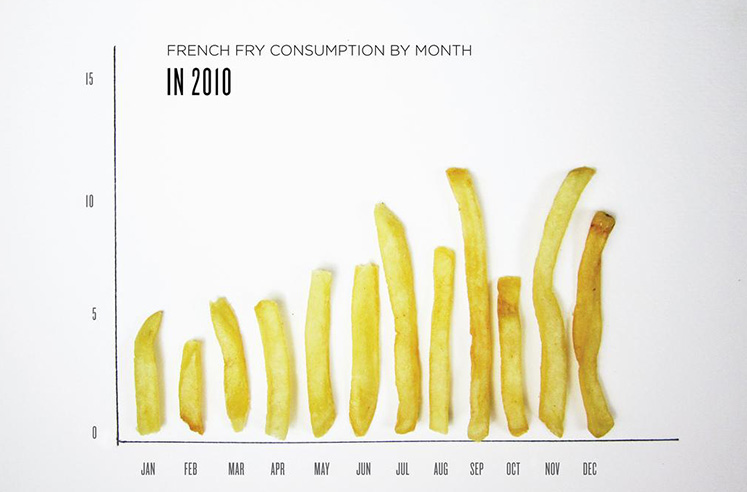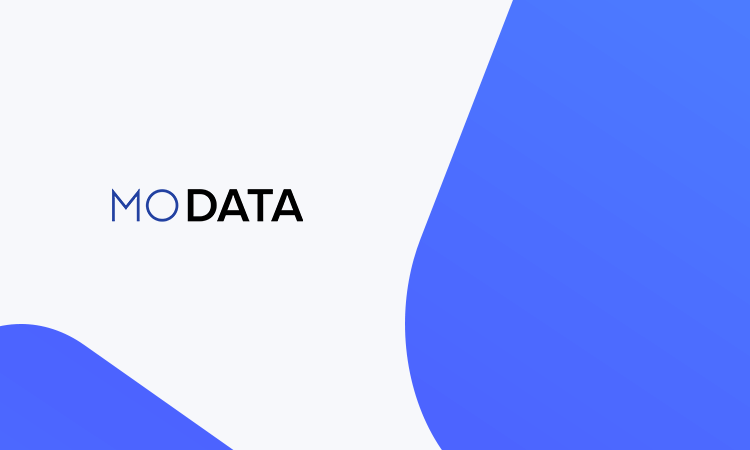
Image: ‘Fries by Month’ photo by Lauren Manning 2006
What is a Data Product?
Technically speaking, a ‘data product’ is an insight or tool created out of existing or purposely acquired raw data that can be used to improve decision making, generally by clients, consumers or other organizations.
These insights may be simple, such as informing a buyer of available inventory three months into the future to help them make better purchasing plans. It may involve benchmarking, where a supplier is presented with how their service levels compare to all other suppliers. It may extend to providing consumer services, such as providing consumers a directory of all the best products.
For any organization, there is not only revenue, but competitive advantage to be gained in developing data products. Possible data products will depend on the organization’s internal systems, its customers and their customers and the mindset with regarding to sharing information up and down the value chain. Coordinating this creativity is the ‘Data Product Manager’
In this post, we provide a high level methodology for identifying and shaping data products.
Methodology for developing data products:
- Understand all areas of the business (especially support functions)
- Inventory all data in all repositories (especially in transactional systems)
- Catalog all insights and where those insights are being used to inform business decisions inside your organization to improve performance at all levels
- Understand your customer’s business and the types of decision they are making and what information they are using to inform those decisions
- Understand your customers customers, what do they look for and what do they value, where are their pain points
- Now ask the question what information do we possess that would help our customers that when added to our customers information could be used to help their customers
- What information might be available in the public domain that might help (social media, weather, geography etc.) whether free or paid for
- Is there any information that each of our customers might have that they might share with us that when aggregated might help all the customers
- What incentives could be put in place to get the clients to share that information
- Is there any application that could be offered to customers customers that would be useful
To create an example, I randomly picked an industry and a company – let’s say we’re targeting the Food Service business for this hypothetical case study and Sysco as a company who is interested in creating data products. Applying these steps, (with a little guesswork involved) to providing some abbreviated answers:
1. What is Sysco’s business
Sysco provides a food supply chain, buying wholesale from farms, food processors and other suppliers, the managing the forecasting, buying and ordering process, they will also operate warehouses and a logistics infrastructure to move food products. The support function would be quality assurance, nutrition experts, finance and sales and marketing
2. Thinking about the data that is flowing through Sysco’s systems
i) Customer: Identification details, Key personnel, transaction history (i.e. orders and order details, returns), issue history, billing (collections and recovery)
ii) Supplier: Identification details, Product data to include prices, nutritional information, transaction history (i.e. orders and order details, returns), issue history, financials
iii) Product Data: Sysco product files, price (and historical price), cost and profitability
iv) Inbound and Warehouse : Inventory data, stock movements, order history, demand forecasts and actuals
v) Outbound and Logstics: Outbound order history,
vi) Fleet information (vehicle inventory, repair and service history, routing and actual geo-location, fuel consumption), Delivery and receipt data
vii) Personnel: Staff records
viii) Sales and Marketing Data: Marketing Campaigns, prospect lists, conversions, cost and revenues
ix) Financial: General ledger, taxes and fees
3. What insights might be being produced inside of Sysco?
i) Financial: Financial ratios (gross margin, operating margin, cost of goods sold, return on assets, current ratio, inventory conversion etc.), invoice accuracy
ii) Inventory: inventory value, carrying costs, turnover, sales order fill rate, warehouse utilization, spoilage, out of stock
iii) Order Management: on time fulfillment, back orders, processing cost per order, orders processed per day
iv) Supplier performance: order accuracy, on time shipments, shipment cost per unit (case/SKU), value of supplier
v) Service delivery: order accuracy, on time shipment, returns
vi) Fleet: vehicle fill, empty running, fuel consumption, time utilization, deviation from schedule
vii) Sales: win-loss analysis, lost sales, collections, customer churn
viii) Marketing: cost per acquisition, conversion funnel
ix) Customer Service: issue tickets, time to resolution, cost per call
4. Understanding Sysco’s customers’ business
i) Typical customers are restaurants and company cafeterias serving food and catering businesses
ii) They are ordering and preparing food (as a finished product based on raw materials supplied by Sysco
iii) Looking to minimize their costs of delivery while maintaining high service levels and a variety of food
iv) Improving customer service levels, increasing profitability of each facility by increasing customer throughput
v) Improving menus in terms of quality and reputation
vi) Maintaining standards of hygiene
vii) Minimizing staff turnover and increasing staff productivity
viii) Reducing food costs and cost of waste or spoilage, increasing profitability of each serving
5. Understanding Sysco’s customers’ customers
i) Diners in each restaurant or cafeteria
ii) Concerned about hygiene, quality of food
iii) Want quick and efficient service in a restaurant with good ambiance
iv) Want to know that they are getting good value
v) Want to be able to find a convenient restaurant where they can find the type of food they like
vi) May have special needs in terms of food allergies, diet, children, disabled access
6. What information might we have that could help our customers and their customers?
Customers (restaurants, cafeterias, catering businesses):
i) Ordering process: typical order lead times, average order size by type and size of restaurant
ii) Menu planning: ingredients lists and proportions, quantity information per serving, price elasticities
iii) Food Information: nutritional information
iv) Delivery routing: routes by day or by hour
v) Overstocked items: advance notice of items in good supply, versus short supply
vi) Seasonal promotions: deals with food suppliers where products available at favorable prices
vii) Benchmark data: comparable orders for similar establishments
Customer’s customers (diners)
i) Nutritional information
ii) Allergy information
iii) Opening hours
iv) Menu information
7. What public domain information might be out there?
i) Restaurant directories and guides
ii) Nutritional information
iii) Allergy information
iv) Food poisoning reports
v) Restaurant hygiene inspection notes
vi) Recipe data
vii) Geo-spatial, map data of restaurants and routes
8. What information might the customers share with Sysco
i) Menus, Ingredient Lists, Recipes
ii) Diner counts / Covers per night
iii) Meal forecasts
iv) Inspection reports
v) Staff counts
vi) Staffing profiles
vii) Restaurant size (sq. footage, tables)
viii) Party booking calendars
9. What incentives might Sysco provide to encourage sharing of information
Sysco might be able to offer restaurateurs a free SaaS based restaurant planning application (calendars, ordering systems and visibility into orders placed – as offered by services such as Restaurant365Software). This would give Sysco instant access to all the aggregated data.
10. What applications might Sysco be able to provide to customer’s customers
If Sysco purchased a service such as AllMenus, then the customer’s menus could be made available directly to customers via an application. The menus could be easily enhanced with nutritional information. In addition, if Sysco purchased a service such as Foodspotting, then the menus could be linked with customer sourced ratings, photographs and reviews. In acquiring those two resources, Sysco would additional gain insight into the types of food customers were looking for and liking and a prospect list of trending restaurants.
Developing your own Data Products
At Mo-Data we are passionate about helping organizations discover new value in their data and then build the systems and processes to allow that value to be realized. Our team has been building data products for the last 10 years and has experience in Data Strategy, Business Intelligence and Insight Discovery from Big Data and from the user generated content in Social Media an addition to this, we will take care of the messy business of preparing your source data so that your analysts and data scientists can maximize the use of their skills and time.
Sysco is already supplying their clients with a huge menu of extended services such as market reports, recipe applications and chef search and perhaps there are data products there too, however,. (Neither Sysco nor any other Food Industry organization is client or prospective of Mo-Data at the time of writing)
For more information about MoData offerings click here




